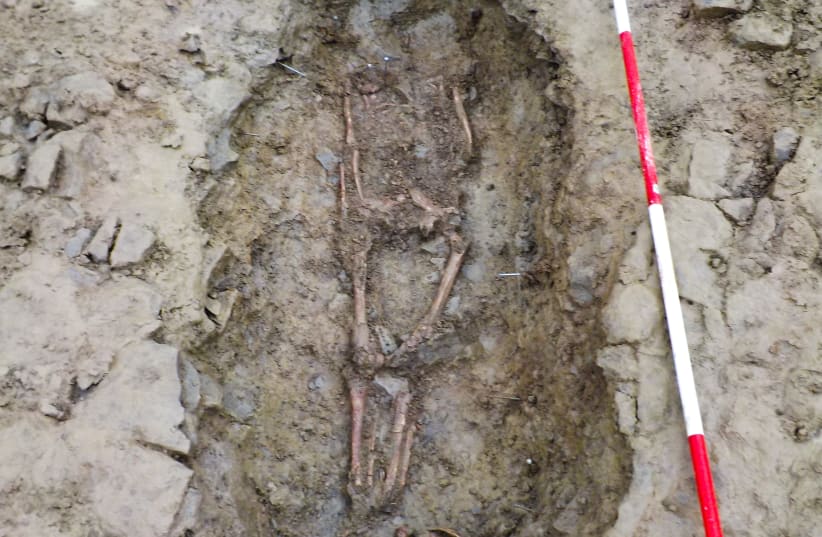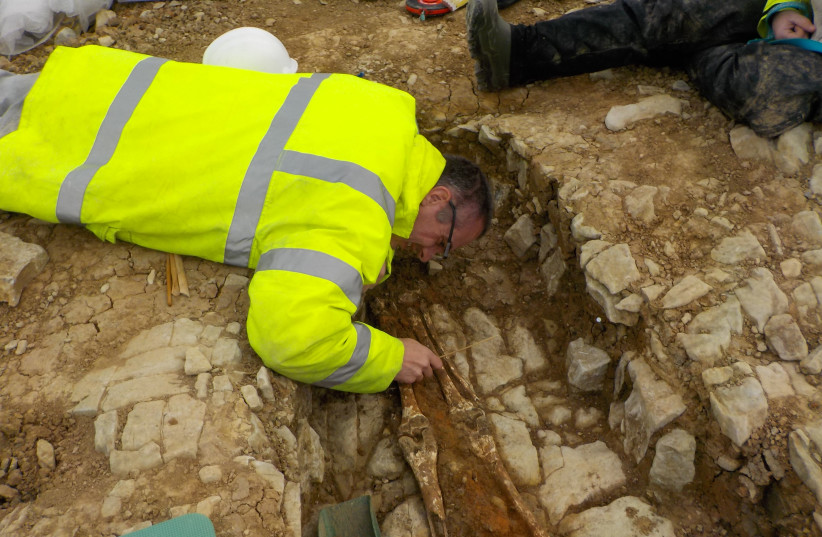The skeleton of a possible Roman mercenary buried facedown and a skeleton with a decapitated head has been uncovered near a Roman villa in an archaeological survey ahead of a road construction project, in Wales, in the United Kingdom.
Decapitation and prone burials are “irregular” burial practices that have long been a focus of Roman archaeology in Britain, though no conclusive reasons as to their significance have yet been definitively established.
The Roman Empire made use of mercenaries throughout its conquests. In Britain, the empire engaged, among others, Frisian fighters from off the southern coast of what is today the Netherlands, and as the empire’s power waned they were brought in to fight off invaders.
However, noted Mark Collard, director of Rubicon Heritage Services which carried out the excavations on behalf of the Vale of Glamorgan, the interpretation of the excavated skeleton as a mercenary is “by no means certain.”
According to an e-book put out by the Vale of Glamorgan council, some 456 other burials were discovered at a burial mound at the site, whose history of multi-period human settlement spans 6,000 years. The burial mound located in a field was first in use during the Bronze Age (2500 BCE-800 BCE) and then later in the early medieval period (410 CE -1169 CE) when people chose to reuse the ancient burial mound for their dead, despite the fact that Christianity had already spread to the area and no church has been found at the site noted researchers. The site had already been known since the 1960s and in this recent excavation yielded remains ranging from the Neolithic period all the way to modern times during World War II.
The possible mercenary skeleton was aligned north-south in the grave, buried prone—face down—with a silver crossbow brooch, iron sword and hobnail boots inside a coffin closed with iron nails, noted the archaeology team in the e-book.
The sword and brooch are indicative of Roman military regalia of late 4th to early 5th century, which has led to the possible mercenary theory, said Collard.
Initial analysis indicates the skeleton belongs to a young adult male probably between 21 and 25 years old and between 1.69m and 1.75m tall (about 5 ft. 9 inches). Researchers said signs of infectious disease are present on the skull, mainly visible on the teeth but also near the ear canal. The man may have suffered from an infection of the middle ear that spread to the brain which may have proved fatal, said the researchers.
“He must have suffered pain in his ear and teeth,” they said.
No signs of trauma or injuries were noted in any of the bones.
Collard said they hope DNA analysis as well as isotope analysis, which can indicate where people grew up as children as they absorb naturally occurring radioactive isotopes from the food and water in their area which vary across the United Kingdom and Europe, will help identify the origin of the young man.
The skeleton of a decapitated man was found buried nearby in an east-west aligned grave, also face down, with the skull by his feet at the eastern end of the Roman period grave. The remains were in poor condition but with the surviving teeth, they were able to establish that these remains also belonged to a young man over 20 years old. Indications of wood within the grave, along with iron nails, could suggest the remains of a coffin or a shroud board, the researchers said.
In February another group of British archaeologists from COPA JV, a consortium formed of three of commercial archaeological contractors in the UK, also announced the discovery of 425 burials, of which some 10 percent were decapitated, in the largest Roman-era cemetery to be excavated in Britain to date.
“One interpretation of this burial practice is that it could be the burial of criminals or a type of outcast, although decapitation is well-known elsewhere and appears to have been a normal, albeit marginal, burial rite during the late Roman period,” they wrote.
Other archaeologists have suggested that this type of decapitation is linked to a pagan belief system of pre-Roman Celtic tribes who considered the head as the container for the soul.
In a 2019 excavation, of 52 skeletons found in a Roman graveyard in Suffolk, England, 17—or 40 percent—of them were decapitated. Archaeologists said then they believed the decapitation had taken place after death.
According to a report published last year in Cambridge University Press by researchers from the University of Cambridge and the University of Bergen hundreds of such burials have been excavated in Britain, with most attention going to decapitation. Explanations proposed for this practice have run the gambit from execution, trophy taking, desecration, human sacrifice, war, cult practice, and banishing witches to a way of helping the soul into the afterlife, a way of preventing the soul reaching the afterlife, and a method for laying the unquiet dead to rest.
Indeed, they said, there is no consensus regarding the significance of such unusual burials.
Archaeologists Rob Wiseman and Benjamin Neil from the University of Cambridge and Francesca Mazzilli from the University of Bergen conducted the research on three Late Roman cemeteries at Knobb's Farm, Cambridgeshire.
They noted that decapitations across Britain make up less than four percent of Roman-era burials, while prone burials are slightly less common at no more than three percent of all burials during that period.
Because such burials are uncommon and in most cases only one or two examples have been found at the same time in cemeteries, studying the practices to understand why they were done and what they meant is difficult, they said.
When the researchers compiled a database using data from 891 burials in 49 Roman era excavated cemeteries in Cambridgeshire and Peterborough, they noted an increase from 5 percent of decapitation burials in the first and second centuries CE to nearly 10 percent in cemeteries dating between the third and fifth centuries CE.
After ruling out numerous possibilities, the researchers concluded that the only two interpretations which might explain the hundreds of decapitated bodies that have been excavated in Britain is either that the decapitation was some form of ritual or cult activity, or that decapitation was legal execution for capital crimes.
Less attention has been given to prone burials and their significance remains unclear, though the researchers suggested that prone burial might have been related to the family's response to execution or an expression of criminality or else a means to prevent the person from rising from the grave.
However, the poor state of preservation of the excavated remains makes it is hard to ascertain how the decapitations had been carried out, they said.
Nevertheless, they did note that there were no cases of defensive injuries, such as cut marks or fractures to the forearms, on the skeletons although a few showed signs of potential injuries which had healed prior to death.
Such evidence led them to conclude that beheadings were not part of a culture of widespread violence such as warfare, banditry or murder as that would have left much wider evidence for other injuries. This suggests a highly controlled use of the practice, they said.
Perhaps, they conjectured, this was connected to the fact that during the third and fourth centuries CE the penalties available under Roman law grew increasingly harsher. The number of crimes that carried the death penalty grew from 14 at the start of the third century to around 60 by the death of Constantine in 337 CE, they said.
“The main drivers of these new penalties were state security and the need to ensure state finances – large portions of which went to the military and state bureaucracy,” they said. “Sites that supplied the army, either contractually or under direct state control, would presumably have been under particular scrutiny, and malfeasance would have been treated harshly.”
After execution, the bodies were probably interred by friends or family, and their burials would have included variations of several funeral rites used locally, they said.
But, they said, because it is unclear to what extent Roman law operated in Roman Britain, particularly in rural areas away from administrative centers, it is difficult to determine whether the decapitation was a result of legal processes.
One thing might be for certain, however, they said, ruling the decapitation out as a way of punishment for slaves or common criminals: “under Roman law, slaves and criminals could be executed using far more painful and humiliating methods, such as crucifixion or being burnt alive.”

